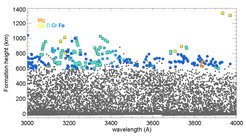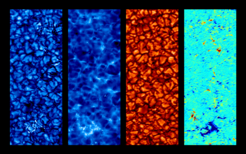
SUNRISE Science Objectives and Results
Sunrise Re-Flight in June 2024: Seeing the Sun with new Eyes
The Sunrise III Science Cases
-
The crucial role of the magnetic field:
The next flight of Sunrise will aim to reveal both, the nature of the photospheric driver as well as the chromospheric response. -
The complex magnetic field in the photosphere:
The wide range of field strengths present on the Sun requires a combination of Hanle and Zeeman diagnostics in multiple spectral lines is needed. This is a major new goal of Sunrise III. -
Turbulent magnetoconvection: origin and fate of magnetic flux:
The emergence of magnetic flux starts below the solar surface and uncovering the nature of the convection (and if possible the magnetic field) in the layers just below the solar surface (a few hundred to a few thousand km) is of utmost importance to learn more about the forces acting on the magnetic features, and possibly to detect signatures of the rising magnetic field itself. To achieve this aim, Sunrise III will provide long time series of velocity and temperature, as well as of the magnetic field, in the photosphere. - The chromosphere:
Sunrise III will answer the basic questions regarding the structure, dynamics, energy transport in and heating of the chromosphere, requiring knowledge of the relevant physical quantities (temperature, density, velocity and magnetic field) in the chromosphere at high spatial and temporal resolution. -
Exploration of the polarised solar spectrum in the UV:
Sunrise III will be the first observatory to study the largely unexplored spectral region between 300 and 410 nm with high spatial resolution. The high density of spectral lines will allow for unprecedented height resolution for magnetic field measurementrs, and bears a large potential for new discoveries.

Formation height of >15 000 spectral lines between 300 and 400 nm. The highest forming lines (above 600 km) of the most common species are marked with colour. These are identified in the legend in the upper left corner of the image. Circles denote neutrals, squares singly ionized species.
The first two Sunrise flights
Sunrise delivered pictures of the solar surface with hitherto unknown quality. Thanks to Sunrise the solar surface could, for the first time, be investigated with high spatial resolution also in the near-ultraviolet between 200 nm and 350 nm, a region which is inaccessible from the ground due to the absorption of these wavelengths in the ozone layer. At these wavelengths also tiny temperature fluctuations within the convective cells stand out with high intensity contrast. With the help of these data, our numerical models of solar surface convection can be put on a firm observational basis. The hitherto almost unstudied near-ultraviolet spectral region is, however, most interesting in view of how the varying solar activity affects the heating of the stratosphere - with potential impact on the terrestrial climate.
One of the big surprises which the Sunrise data revealed is the extremely dynamic behavior of the granulation on even the smallest scales: Eddies and tornadoes are clearly visible in the data and appear at much higher rates than described in previous studies. The turbulent convective gas flows are at origin of acoustic waves with a frequency spectrum spanning several orders of magnitude. While slow waves with periods of 3 min and above are reflected at the upper boundary of the photosphere and lead to standing wave patterns (the famous p-modes, which form the analytical basis for the internal structure of the Sun, a technique called Helioseismology in analogy to telluric seismology), shorter period waves can penetrate into high layers of the solar atmosphere, the so-called chromosphere, where they lose their energy by wave dissipation. It is an unsolved mystery why the chromosphere is hotter than the underlying photosphere. Which role do these waves play here?
Thanks to the enormous spatial resolution of the Sunrise data, the acoustic energy flux could be determined with unprecedented accuracy: It becomes clear that more than half of the energy which the chromosphere radiates is supplied by acoustic waves. This result is very surprising, although this mechanism was theoretically described already 40 years ago. But due to the limited quality of previous observations, the efficiency of this acoustic heating of the chromosphere has been underestimated for a long time.
In the ”intergranular lanes”, dark stripes of downflowing cold gas in between the granules, magnetic fields are amplified and concentrated in flux tubes with diameters of 100 km or below, but very high field strengths: The magnetic field there is up to 500 times stronger than at the poles of the Earth. These basic building blocks of solar magnetism were predicted some 40 years ago, but could be observed in an only limited, indirect way. Sunrise could now for the first time directly observe such flux tubes, also confirming the expected increase in temperature within these structures. This important result will contribute to our understanding of the connection between the Sun’s magnetic activity and its total brightness, which is considered responsible for the solar influence on terrestrial climate.
Since the typical life time of the convective cells is only several minutes, the magnetic field is extremely dynamic and found in continuous emergence, development, and annihilation. The total magnetic flux per time, as measured by Sunrise/IMaX, is higher by two orders of magnitude than previously known, confirming that most of the magnetic elements are hidden on very small scales.

Although the individual magnetic elements are extremely small, they have significant influence on the structuring of the solar atmosphere. This can also be seen in observations of the Sunrise/ SuFI instrument, obtained in the near ultraviolet spectrum. Thanks to the high spatial and temporal resolution, these data show how the movements of the flux tubes in the lower parts of the solar atmosphere cause short-lived and localized temperature increases in the overlying chromosphere. This is an important result, which demonstrates how the different layers of the solar atmosphere are interconnected and coupled by the magnetic fields.
While it may seem that the Sunrise data depict only a tiny part of the Sun, they are nevertheless long sought-for important pieces, which have already proven to be important contributions to solving the puzzle that the Sun still represents to us.
The data of the second science flight in June 2013 are still being processed and analyzed. We expect them to give us equally exciting insight into the workings of the Sun.

